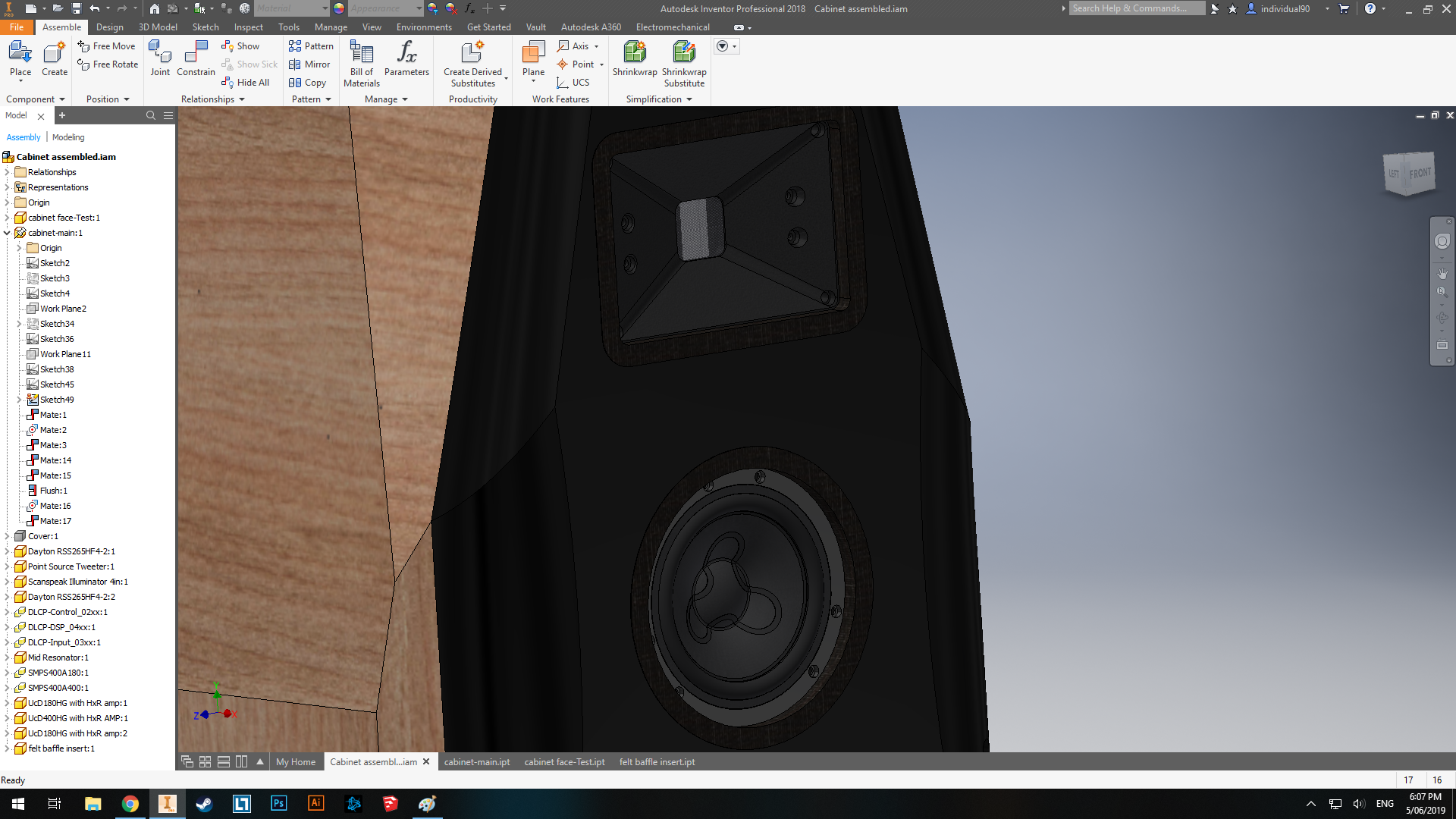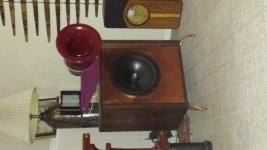I've been through a lot of the threads here regarding baffle diffraction (ad nauseam) , but I have a quick design question. Im designing some large active floorstanders, and I was wondering, If i recessed my drivers and added a felt strip flush with the baffle face (also helps with my time alignment) would this help baffle diffraction significantly? My guess is that off-axis response might be diminished a bit also.
In the first image they are flush mounted, and my baffle edges have large fillets (rounded chamfers) and multiple angled chamfers

in this one is with the felt strip surround.

Anyone have any input, or know if this has been done?
Much appreciated.
In the first image they are flush mounted, and my baffle edges have large fillets (rounded chamfers) and multiple angled chamfers

in this one is with the felt strip surround.

Anyone have any input, or know if this has been done?
Much appreciated.
Yes.
Read on for more info.
Try foam if you can first.
F10 felt is not cheap, but a lot of wool content.
I used f10 1/2" around dome tweet in my morel solstice.
Looking on amazon, i see 1/2" f10 12" x 12" for $22.5 (free shipping).
Felt Sheet, F10, 1/2 in T, 12 x 12 in: Amazon.com: Industrial & Scientific
I dont know why the felt store adds $19.5 shipping, ouch.
1/2" seemed to help down to 1,100hz.
Diffraction Doesn't Have to be a Problem
I should get my but moving and felt around my horn mouth.
You should be fine.
People loved dunlavy speakers, they had sunken tweets for time alignment too, felt around them also, just like what you are proposing.
Read on for more info.
Try foam if you can first.
F10 felt is not cheap, but a lot of wool content.
I used f10 1/2" around dome tweet in my morel solstice.
Looking on amazon, i see 1/2" f10 12" x 12" for $22.5 (free shipping).
Felt Sheet, F10, 1/2 in T, 12 x 12 in: Amazon.com: Industrial & Scientific
I dont know why the felt store adds $19.5 shipping, ouch.
1/2" seemed to help down to 1,100hz.
Diffraction Doesn't Have to be a Problem
I should get my but moving and felt around my horn mouth.
You should be fine.
People loved dunlavy speakers, they had sunken tweets for time alignment too, felt around them also, just like what you are proposing.
Last edited:
It isn't clear in the pics to me, but it looks like there are two diffraction edges. Rounded bevels at the edges of the black baffle, and again with the wooden section.
I've not heard this, but I worry this would causue two separate diffraction events.
One option is to mount the tweeter on a baffle, with no box. That is, stop the cabinet at the bottom of the tweeter, and leave the tweeter free standing. It looks pretty good. 🙂
Best,
E
I've not heard this, but I worry this would causue two separate diffraction events.
One option is to mount the tweeter on a baffle, with no box. That is, stop the cabinet at the bottom of the tweeter, and leave the tweeter free standing. It looks pretty good. 🙂
Best,
E
So your answer to this broad question is to combine it all into one almighty bunch?I've not heard this, but I worry this would causue two separate diffraction events.
One option is to mount the tweeter on a baffle, with no box. That is, stop the cabinet at the bottom of the tweeter, and leave the tweeter free standing.
Hey Allen,
No real solution from me. I'm more pointing out there are a number of unique combinations here. There's a round edge, plus a chamfered edge, plus a tweeter in a wave guide.
Aside from the visual, it would be interesting to hear how this adds up.
Usually we see rounded OR chamferred. The former with wider designs. The latter with narrow. This box has all that PLUS a wave guide.
I wonder, out of genuine curiosity:
- Whether the wave guide negates all the chamfering and rounding.
- If it does, what a dome tweet without a WG would sound like in this dual edge design.
and propose a couple of options.
Best,
E
No real solution from me. I'm more pointing out there are a number of unique combinations here. There's a round edge, plus a chamfered edge, plus a tweeter in a wave guide.
Aside from the visual, it would be interesting to hear how this adds up.
Usually we see rounded OR chamferred. The former with wider designs. The latter with narrow. This box has all that PLUS a wave guide.
I wonder, out of genuine curiosity:
- Whether the wave guide negates all the chamfering and rounding.
- If it does, what a dome tweet without a WG would sound like in this dual edge design.
and propose a couple of options.
Best,
E
Yes.
Read on for more info.
Try foam if you can first.
F10 felt is not cheap, but a lot of wool content.
I used f10 1/2" around dome tweet in my morel solstice.
Looking on amazon, i see 1/2" f10 12" x 12" for $22.5 (free shipping).
Felt Sheet, F10, 1/2 in T, 12 x 12 in: Amazon.com: Industrial & Scientific
I dont know why the felt store adds $19.5 shipping, ouch.
1/2" seemed to help down to 1,100hz.
Diffraction Doesn't Have to be a Problem
I should get my but moving and felt around my horn mouth.
You should be fine.
People loved dunlavy speakers, they had sunken tweets for time alignment too, felt around them also, just like what you are proposing.
Price isnt a concern in this build lol so far my material and drivers/electronics total is around 7k australian.
Ive never heard of Dunlavy before, definitely going to check them out.
It isn't clear in the pics to me, but it looks like there are two diffraction edges. Rounded bevels at the edges of the black baffle, and again with the wooden section.
I've not heard this, but I worry this would cause two separate diffraction events.
With the round edge being as large as it is, and blending into the chamfer, would it not just be one diffraction? If the chamfer didnt blend then I could understand. Sorry, new to the complexities of acoustics lol
My guess is
as good as anyone else.
put together a prototype and measure it.
You make a compelling case for experimentation. Diffraction may encounter conflicting factors as to why it is both more and less critical at a given distance.I wonder, out of genuine curiosity:
- Whether the wave guide negates all the chamfering and rounding.
- If it does, what a dome tweet without a WG would sound like in this dual edge design.
At what frequency does baffle defraction become an issue? My speakers woof has a lot of baffle around it but the mid horn and tweet stand in free air.
Attachments
Last edited:
Allen,
Yeah, either experiment or simplify the problem space, which is where my suggestions where going.
Yeah, either experiment or simplify the problem space, which is where my suggestions where going.
At what frequency does baffle defraction become an issue? My speakers woof has a lot of baffle around it but the mid horn and tweet stand in free air.
Till there isn't one 😉 Now baffle diffraction is limited to the driver's eigenmodes, so baffle or not, a damping ring is still required, i.e. your horns need them too unless they have a round over with a radius > the horn's lowest frequency and even then a foam plug may be required. 🙁
GM
- Status
- Not open for further replies.
- Home
- Loudspeakers
- Multi-Way
- Baffle diffraction
